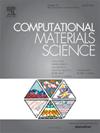Atomistic modelling of femtosecond laser melting of Pb nanoparticles embedded in Al film
IF 3.1
3区 材料科学
Q2 MATERIALS SCIENCE, MULTIDISCIPLINARY
引用次数: 0
Abstract
Ultrashort pulse laser irradiation of nanoparticles embedded into a matrix with a higher melting point presents a case study for investigation of the kinetics and mechanisms of nanoscale melting occurring in the absence of surface nucleation of liquid phase. The ultrahigh heating rates induced by femtosecond laser irradiation, ∼1015 K/s, create conditions of substantial superheating prior to the onset of rapid homogeneous melting. The suppression of surface nucleation of liquid phase in the embedded nanoparticles can further increase the maximum values of superheating, but the detailed understanding of the kinetics and mechanisms of melting under confinement by the matrix material is still lacking. In this study, the melting of an octahedral 20 nm Pb nanoparticle embedded into a 30-nm-thick Al film and irradiated by a 110 fs laser pulse is investigated in a series of molecular dynamics simulations. The heating of the embedded Pb nanoparticle is found to be a multi-stage process controlled by the relative strength of the electron–phonon coupling of the nanoparticle and matrix material. The compression of the nanoparticle due to the confined thermal expansion and volume increase upon melting has a strong effect on the equilibrium melting temperature. When this effect is accounted for, the maximum level of superheating achievable prior to melting is consistent with that required for the onset of homogeneous melting in bulk systems. The key factors that define the kinetics of melting at moderate laser fluences are (1) the negative feedback to the melting process provided by the compressive stresses generated due to the volume expansion upon melting of the Pb nanoparticle, (2) the stabilization of the crystal structure in the vicinity of semicoherent {1 1 1} interfaces with the matrix, and (3) the gradual resupply of the thermal energy transformed to the heat of melting by the heat transfer from the Al matrix. As a result, the laser fluence range where the melting proceeds slowly, on the timescale of hundreds of picoseconds, is substantially expanded as compared to free-standing nanoparticles or films irradiated by ultrashort laser pulses.

求助全文
约1分钟内获得全文
求助全文
来源期刊

Computational Materials Science
工程技术-材料科学:综合
CiteScore
6.50
自引率
6.10%
发文量
665
审稿时长
26 days
期刊介绍:
The goal of Computational Materials Science is to report on results that provide new or unique insights into, or significantly expand our understanding of, the properties of materials or phenomena associated with their design, synthesis, processing, characterization, and utilization. To be relevant to the journal, the results should be applied or applicable to specific material systems that are discussed within the submission.
 求助内容:
求助内容: 应助结果提醒方式:
应助结果提醒方式:


